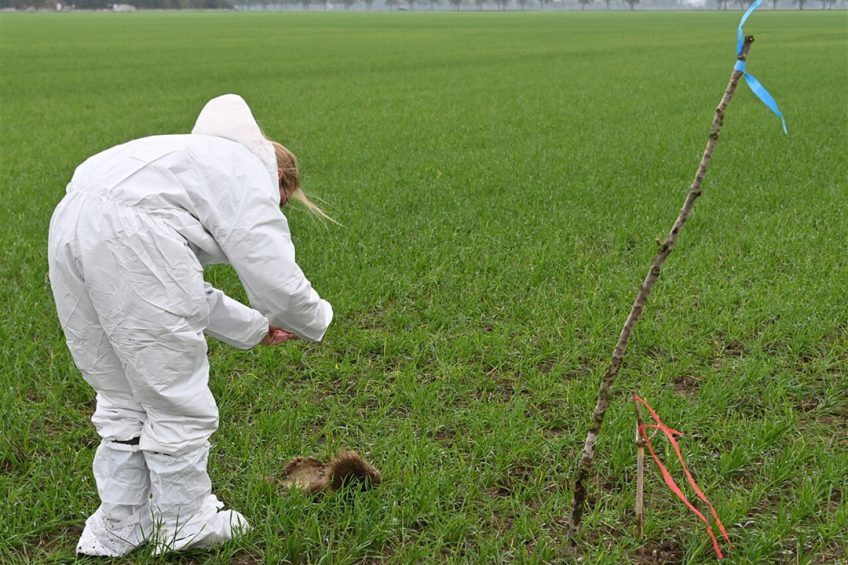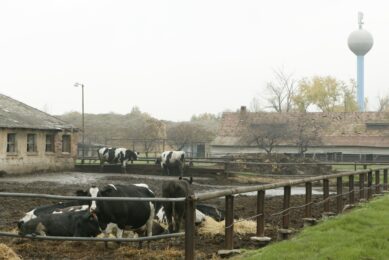ASF Germany: Group of sick and dead wild boar found

During a search operation in eastern Germany in the context of African Swine Fever, a herd of mostly sick and dead wild boar has been spotted near the border with Poland. The herd is said to include at least 30 animals.
The group was discovered on the island Küstrin-Kietz, which is part of the northern infection zone in eastern Germany, immediately bordering Poland. The discovery was made during an intensive search day last Saturday which involved at least 300 helpers on land, in the sky (using 4 drones, some with heat cameras) and in the water (at the Oder river, forming the border between the 2 countries).
By intensive surveillance, the idea is to identify and remove as many carcasses as possible before they further infect other wild boar. However, it looks like the amount of boar victims keeps on growing.
The location of the island Küstrin-Kietz has temporarily been highlighted with a red star in the interactive map below. This will remain until more detailed information about numbers and location becomes available. That is expected to happen in the course of the week.
Sick wild boar discovered by drone
The discovery was made when studying images captured by a drone. Thomas Behrendt, spokesperson of the district Märkisch Oderland, told public broadcaster RBB: “Half of the animals is already dead and the other half was clearly ill.”
Further research into this group proves to be difficult, therefore the animals will be observed using drones. Behrendt said, “Taking action would be too dangerous, as sick may run away and further spread the virus.” In addition, the island is known to be home to ammunition, which is why it cannot be entered.
The video below (in German), published by RBB, shows footage of a litter of wild boar of which some animals are dead and some are on the way to die. The sow has already died, according to the video.
The search on Saturday also yielded also further carcasses, which are being researched at the moment. In total, an rea of roughly 45 km2 was explored around the town of Bleyen. The fire brigade, police, hunters, farmers and district employees participated in the search.
Total official count: 55 infected wild boar
The official count of infected wild boar in Germany was 55 at the beginning of the weekend; 2 of which were found in the northern infected area in Märkisch Oderland district. The southern infected area, also bordering Poland, comprises parts of Spree-Neisse district and Oder-Spree district. In this area, in total 53 animals were reported infected by the beginning of the weekend.
The German authorities have also enlarged the so-called at risk area in eastern Germany, which is the area surrounding the 2 infected zones (not indicated on the interactive map above). This area now also includes the city Frankfurt an der Oder. Having done so, the districts will now adapt their general animal disease directives accordingly, wrote Germany’s agricultural title Top Agrar. The total at risk area now measures roughly 2,200 km2.
Annoyance over field closure
In the meantime, the consequences of the ASF approach lead to annoyance in Germany’s farming community. In the risk area, there have been limitations placed on what is possible on the arable fields. This applies to 70,000 hectares of arable land in the 3 districts Oder-Spree, Spree-Neisse and Märkisch-Oderland.
Many of them would like to harvest and deliver to the market – some farmers have even called the policy by the Brandenburg authorities “a complete failure”, according to Top Agrar.
Exemptions from ban on agricultural areas
Late September, the state approved the 1st exemptions from the ban on agricultural and forestry areas in the risk area. The prerequisite for clearance, however, is that the areas have been thoroughly examined for the presence of dead or sick wild boar by the authorities.

Track the movement of African Swine Fever
For everything you need to know about ASF, from the latest outbreaks to controls stay up to-date…
This process, however, is not really speeding up, most likely because staff is lacking, Top Agrar wrote. Only in the Oder-Spree area, about 350 applications were waiting for approval last week; the district announced to make big steps.
Electronic wild boar fences a reason for concern
Electronic fences are also a reason for concern. One farmer near the town Oderbruch reported in the newspaper MOZ that between 50-100m of fence was just flat on the floor, he suspected it was just run over by wild boar. He also observed that the running animals simply break through the fences. The authorities are in the process of constructing permanent fences at the border. These take time to construct.
Situation in western Poland
Meanwhile, in neighbouring western Poland the number of infected carcasses has exceeded 2,000 – late last week the count was at 2,024 in the cluster in western Poland alone. Amongst the most recent finds was a case at 7.5 km from the border with Germany – never before an infected carcass was reported this close to the German border.
99 pig farms in Poland with ASF in 2020
In the whole of Poland, including the larger infected area in the east, the total amount of infected pig farms (from backyard to commercial production) has risen further to 99. With that amount, the year 2020 has overtaken the “record-holding” year 2018, when in total 95 farms were infected. The total amount of pig farms that contracted ASF since the virus’ first infection in 2014 is now at 336. Normally, in the colder winter months, hardly any farms get infected.
In western Poland so far 11 farms have been affected by ASF in 2020.











